
- Introduction
- Knowing your Fruit Tree
- Choosing a Site
- Preparing the Soil
- Planting, Culture, and Fertilization
- Insects and Diseases
- Harvesting, Storing, and Consumption
- Recommended Cultivars
Introduction
Growing peaches and other fruit trees in Georgia and the southeastern United States is challenging. Peaches are not native to North America; however, many cultivars have been developed for our area, and Georgia has a long history of successful peach production. One must choose the site and the proper cultivar and provide care throughout the year to be successful.
Knowing your Fruit Tree
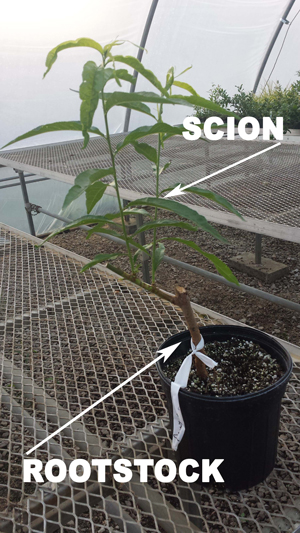 Grafted peach plant. Photo by Dario Chavez.
Grafted peach plant. Photo by Dario Chavez.Peach trees should be purchased from reputable nurseries to assure healthy trees of the desired cultivar/rootstock combination. The tree is composed of a scion (shoot) of a particular cultivar (i.e. variety) grafted onto a rootstock. This rootstock can be grown from seed or through clonal propagation. Normally, the rootstock has been bred and selected for adaptation and resistance/tolerance against soil pests and diseases for the location. It is important to make sure that you have the best rootstock for your area. The rootstocks currently available are Guardian, MP-29, Halford, and Nemaguard. If you are located in south Georgia, you may find other rootstocks in addition to the ones described above, such as Flordaguard and Sharpe.
The peach tree will change throughout the growing seasons. In the spring, the tree will bear pink flowers. After blooming, the green foliage will emerge. In the summer, ovaries from pollinated flowers will swell forming small fruit. Fruit will continue to mature until ripening. In the fall, the foliage will turn reddish-orange until finally dropping at the end of the fall.
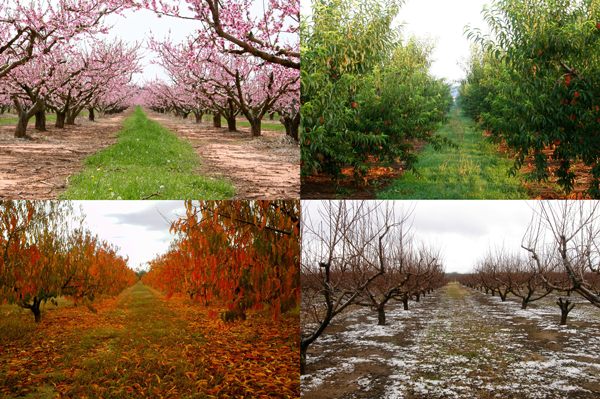 A peach orchard changes depending on the season. Top left: spring. Top right: summer. Bottom left: fall. Bottom right: winter. Photos courtesy of the Georgia Peach Council.
A peach orchard changes depending on the season. Top left: spring. Top right: summer. Bottom left: fall. Bottom right: winter. Photos courtesy of the Georgia Peach Council.Choosing a Site
Choosing the right place for a fruit tree to grow is very important for overall success. Peach trees require a site with well-drained soil and ample sunlight. Poorly drained soils can lead to poor tree growth and often times tree death. Peach trees need to have sun from 8 to 10 hours per day. This amount of sunlight will assure sufficient photosynthesis and promote tree health and vigor.
Another aspect to think about when choosing the site is the tree size. Peach trees on Sharpe and on MP-29 rootstocks (semi-dwarf) will spread 12-15 feet, while standard trees will be twice the size (such as in Guardian, Halford, and Nemaguard rootstocks).
It is important to protect the trees from winter winds. If the garden is on a slope, the peach trees should be planted on the side of the hill to diminish the effects of the wind and cold.
Preparing the Soil
Test the soil prior to planting, as an adequate adjustment of pH and fertility may be required. This is particularly important because modifying soil pH in deeper profiles is very difficult after planting. Soil testing kits can be obtained from your local UGA Extension office. You can locate the closest county office with the online directory.
Using a soil probe, collect the soil from several different locations at a depth of 6-8" to obtain a proper soil sample. Mix the soil together in a clean, non-metal container and place 3-4 handfuls of this mix into the bag for the soil test. The soil test results will provide you with a recommendation based on the crop and your soil conditions. Soil pH for peach trees should be between 6 and 6.5.
Planting, Culture, and Fertilization
Ideally, you should preorder your peach trees to obtain the rootstock/scion combination you want from a nursery. Many nurseries will have a catalog with a detailed description for each variety, including the rootstocks that are available. You can ask the nursery to help you identify good varieties that will grow with fewer problems at your location.
One of the main factors to determine if a peach tree is adapted to a location is the chill hours. Each variety has a different chill hour requirement that has to be satisfied to enable normal plant growth and fruiting. A chill hour is the amount of time that the temperature is between 32 degrees F and 45 degrees F. You can find this information using the Georgia Weather System. Within this system, click on the location that is closest to you and look for the link to the chilling hours calculator. To calculate the chilling hours, choose dates from October 1 to February 15. You will then be able to see the historical chill hours within your area, which can be used as thresholds to select the best varieties suited for your location.
The peach trees are usually delivered in late December or at the beginning of January. Peach trees can be planted in December through February, while still dormant. They will either come as potted or bare root plants. Bare root plants will require immediate action. Keep the roots moist and in the shade until planting.
To plant a peach tree, dig a hole twice as wide as the width of the rootball and deep enough so that the tree is at the same depth that it was in the nursery. Gently spread the roots in the hole and cover them with soil. Do not add any compost or soil amendment. Firm the soil around the stem and remember to water the soil thoroughly after finishing.
For optimum future growth, plant your trees about 18 to 20 feet apart. Once the tree starts growing, remove any suckers that arise from below the graft. This can be done with your hands or hand clippers in order to slow or stop them from regrowing.
Weeds should be controlled with hand weeding, using mulch (hay), or very careful application of herbicides. Weeds, especially grasses, will outcompete peach trees for water and nutrients. If you use herbicides, make sure to keep the spray from drifting to the trunks of your young peach trees. One effective way to protect young trees from accidental herbicide injury is to place a paper milk carton over the trunk at planting. The paper milk-carton will degrade over time, but it will provide a good herbicide shield until it begins to disintegrate.
Do not fertilize newly planted, first year, peach trees until March. At that time, apply 1 lb of 10-10-10 fertilizer per tree, broadcasting evenly 4 to 5 inches away from the tree trunk. In May, broadcast 1 lb of calcium nitrate, 6 inches away from the tree trunk. In July, broadcast 1 lb of calcium nitrate over a 6-inch diameter circle.
Second year fertilization starts in March by applying 2 lb of 10-10-10 fertilizer per tree broadcast evenly over a 6 inches diameter circle. In May, broadcast 1.25 lb of calcium nitrate, 6 inches away from the tree trunk. In July, broadcast 1.25 lb of calcium nitrate over a 6-inch diameter circle.
Starting from third year and on, apply similar rates as the second year with a supplemental 0.15-0.25 lb per tree per application adjusted as follows: a postharvest application based on the tree's terminal growth and a spring application based on the crop load. If the trees do not show any symptoms of deficiency, and tree growth and yield are adequate, just maintain fertilization rates as on year 2. Evaluate and define each year's fertilization based on these recommendations.
These applications should be modified if a preplant soil testing was done and recommendations were followed, as phosphorus and potassium should not be needed for the first and second years of tree life. For more detailed information view the Southeastern Peach, Nectarine, and Plum Pest Management and Culture Guide.
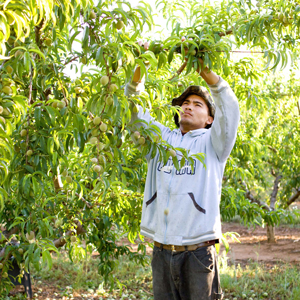 Fruit thinning. Photo courtesy of the Georgia Peach Council.
Fruit thinning. Photo courtesy of the Georgia Peach Council.During the winter season, pruning is vital for next year's crop. It is recommended to keep four scaffold limbs with an open, vase-like center. See suggested pruning techniques for peaches in the UGA Extension publication, "Peach Orchard Establishment and Young Tree Care" (Circular 877).
In order to assure good fruit size, peaches will almost always have to be thinned. Fruit thinning is normally done when the fruit is about 0.7- to 1.0-inch across. Peach trees naturally produce hundreds of fruitlets. To achieve desirable and consistent fruit size, leave a healthy, well shaped fruitlet every 6 to 8 inches. Although it may seem that you are removing most of the crop, thinning will assure a good fruit size and quality crop when ripe.
Insects and Diseases
Peaches are one of the more difficult fruit crops for homeowners to grow in Georgia because they have many diseases and insect pests. It is important to follow a spray regime to protect your fruit and trees. Brown rot disease and the plum curculio insect have the potential to destroy the entire fruit crop without a good management program.
The home orchard section of the annually updated University of Georgia Pest Management Handbook — Homeowner Edition provides recommendations for controlling and preventing diseases and insects of commonly grown home orchard crops such as peaches. The most common problems are:
Insect Pests
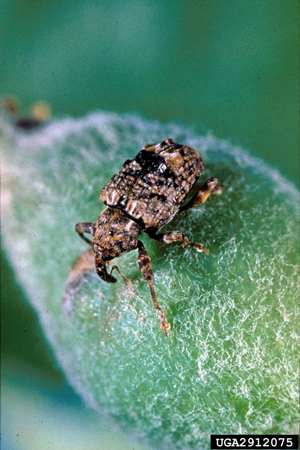 Plum curculio. Photo courtesy of Clemson University - USDA Cooperative Extension Slide Series, Bugwood.org.
Plum curculio. Photo courtesy of Clemson University - USDA Cooperative Extension Slide Series, Bugwood.org.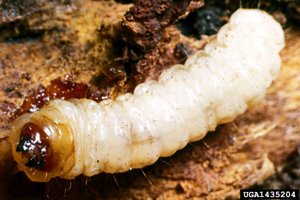 Peachtree borer. Photo courtesy of Clemson University - USDA Cooperative Extension Slide Series, Bugwood.org.
Peachtree borer. Photo courtesy of Clemson University - USDA Cooperative Extension Slide Series, Bugwood.org.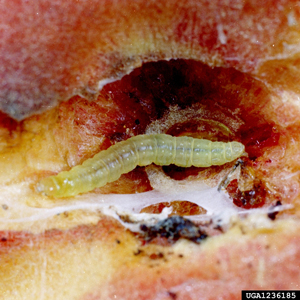 Oriental fruit moth. Photo courtesy of Clemson University - USDA Cooperative Extension Slide Series, Bugwood.org.
Oriental fruit moth. Photo courtesy of Clemson University - USDA Cooperative Extension Slide Series, Bugwood.org.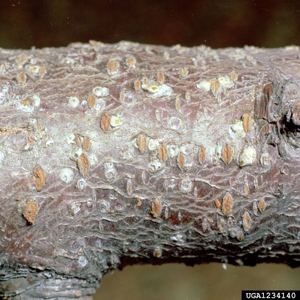 White peach scale. Photo courtesy of Clemson University - USDA Cooperative Extension Slide Series, Bugwood.org.
White peach scale. Photo courtesy of Clemson University - USDA Cooperative Extension Slide Series, Bugwood.org.- Plum curculio is the key fruit insect pest that attacks peaches in Georgia and adjacent Southeastern states. These small, native weevils (snout-beetles) are found on numerous wild hosts. Plum curculio can cause injury all season long and it is difficult to scout well enough to spray only as needed. In most of Georgia, plum curculio damage is typically most pronounced from petal drop at the end of fall through the end of April. Damage typically picks up again as peaches ripen.
The peaches often produce gum at the sites of curculio wounds. The larvae mature in the dropped fruit, so prompt removal of any infested fruit from the ground or tree is important. Preventative sprays are the only means of effectively preventing plum curculio damage. - Peachtree borer and lesser peachtree borer are caterpillar pests that feed on the inner bark, causing major damage to the tree's vascular system. Peachtree borers attack the lower trunk and the major roots, while lesser peachtree borers attack the structural wood throughout the tree. Adults lay eggs in the wound areas. Larvae bore into the vascular tissue, impairing the flow of water and nutrients, and ultimately killing the limb or even the entire tree. Late summer application of insecticides can help. Avoid making large pruning cuts that leave excessive wounding.
- Oriental fruit moth, in the caterpillar stage, attack and tunnel within the stems of succulent new vegetative growth and damage the fruit. Though typically regarded as the most impactful fruit-feeding pest of peaches worldwide, in most of Georgia the Oriental fruit moth is only a minor fruit pest. The caterpillar does modest injury to the terminals of new growth in the spring and again during the annual vegetative growth flush.
- Scale insects are very small insects that attach to limbs and trunks and can cause tree death. Oil sprays should be applied annually on dormant trees to control scale insects.
- Mites usually occur in late summer and in dry seasons. Leaves become stippled and in severe cases webbing can be seen on the foliage.
Diseases
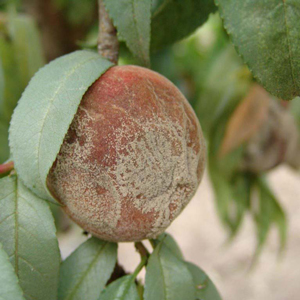 Brown rot. Photo courtesy of Phil Brannen, University of Georgia, Plant Pathology.
Brown rot. Photo courtesy of Phil Brannen, University of Georgia, Plant Pathology. 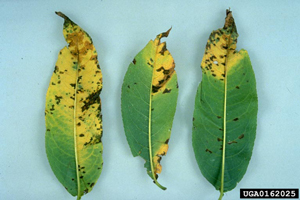 Bacterial spot. Photo by U. Mazzucchi, Università di Bologna, Bugwood.org.
Bacterial spot. Photo by U. Mazzucchi, Università di Bologna, Bugwood.org.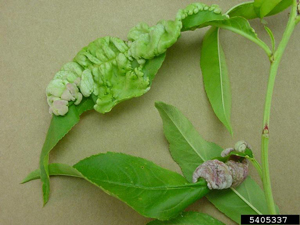 Peach leaf curl. Photo by Paul Bachi, University of Kentucky Research and Education Center, Bugwood.org.
Peach leaf curl. Photo by Paul Bachi, University of Kentucky Research and Education Center, Bugwood.org. 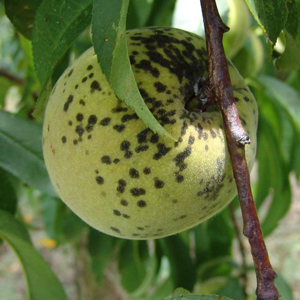 Peach scab. Photo courtesy of Phil Brannen, University of Georgia, Plant Pathology.
Peach scab. Photo courtesy of Phil Brannen, University of Georgia, Plant Pathology. - Brown rot is caused by a fungus that can infect flowers, shoots, and fruit. It is the most damaging stone fruit disease in terms of fruit loss. It is very difficult to manage in Georgia without fungicides. In most years, 100% of the ripening fruit can be lost to this disease in unsprayed trees. The severity of the disease can vary from year to year depending on the amount of moisture. Removal of all the old fruit at the end of the season and proper pruning during the dormant season will cut back on brown rot infections the following year. Check with your county agent for information on spray programs.
- Bacterial spot and leaf curl are leaf diseases that may cause problems in certain years or locations or on certain cultivars. Bacterial spot is a sporadic leaf spot disease, which when severe, can cause some defoliation in certain cultivars. Select cultivars that are adapted to the East. Leaf curl is also sporadic in occurrence. Infected leaves become reddish, thickened, twisted, and drop prematurely.
- Scab is a fruit and twig disease that causes superficial blemishes on the fruit. Sprays for brown rot will also protect against scab.
For more in-depth explanation on the management of peach diseases, insect, and weed problems contact your local Extension office.
Harvesting, Storing, and Consumption
Different cultivars ripen at various times from early May to late August or early September. Harvesting time depends on the final use of the fruit. Normally, peach fruit is harvested when ripe. This is typically when fruit is firm and has a yellow (for yellow flesh peaches) or cream (for white flesh peaches) background color and wonderful aroma. Hard fruit that are not quite ripe can be used for pickling, while over ripened fruit has to be used quickly. There are several ways to preserve peaches once pickled. A good resource on preserving fruit is the UGA Extension family and consumer sciences website where you can find a link to the National Center for Home Food Preservation, fact sheets on food preservation, contact information for a family and consumer sciences agent near you, and an order form for the "So Easy Preserve" book.
Recommended Cultivars
|
Note. Each variety is described by harvest period, chilling requirement, flesh color (yellow or white), flesh texture (melting or non-melting), pit attachment (clingstone, semi-clingstone, or freestone), and bacterial spot susceptibility (susceptible/resistant). This first part of the table covers those with an April–May harvest period. |
||||||
| Harvest Period | Chill | Variety | Flesh Color | Flesh Texture | Pit Attachment | Bacterial Spot Susceptibility |
|---|---|---|---|---|---|---|
| Late April | Low chill, <600 hours | Flordadawn* | Yellow | Melting | Clingstone | Resistant |
| Early May | Low chill, <600 hours | Gulfcrest* | Yellow | Non-melting | Semi-clingstone | Resistant |
| Flordacrest* | Yellow | Melting | Semi-clingstone | Resistant | ||
| Mid May | Low chill, <600 hours | Flordaking* | Yellow | Melting | Clingstone | Resistant |
| Gulfking* | Yellow | Non-melting | Semi-clingstone | Resistant | ||
| Mid May | Moderate chill, 600-750 hours | Regal | Yellow | Melting | Semi-clingstone | Highly Susceptible |
| Late May | Low chill, <600 hours | Gulfprince* | Yellow | Non-melting | Clingstone | Highly Resistant |
| Late May | Moderate chill, 600-750 hours | Springprince | Yellow | Non-melting | Clingstone | Moderately Susceptible |
| Empress | Yellow | Melting | Clingstone | Moderately Susceptible | ||
| Goldprince | Yellow | Melting | Clingstone | Resistant | ||
| Late May | High chill, 750-900 hours | Camden | Yellow | Melting | Clingstone | Susceptible |
| Sunbrite | Yellow | Melting | Clingstone | Susceptible | ||
| Rubyprince | Yellow | Melting | Clingstone | Moderately Susceptible | ||
| Harvest Period | Chill | Variety | Flesh Color | Flesh Texture | Pit Attachment | Bacterial Spot Susceptibility |
|---|---|---|---|---|---|---|
| Early June |
Moderate chill, 600-750 hours | Juneprince | Yellow | Melting | Semi-clingstone | Resistant |
| Southern Pearl | Yellow | Melting | Semi-clingstone | Resistant | ||
| Junegold | Yellow | Melting | Clingstone | Resistant | ||
| Early June | High chill, 750-900 hours | Summerprince | Yellow | Melting | Semi-clingstone | Resistant |
| Garnet Beauty | Yellow | Melting | Semi-clingstone | Resistant | ||
| Early June | Very high chill, > 900 hours | Harrow Diamond | Yellow | Melting | Semi-clingstone | Resistant |
| Mid June | Moderate chill, 600-750 hours | Coronet | Yellow | Melting | Semi-clingstone | Resistant |
| Mid June | High chill, 750-900 hours | Gala | Yellow | Melting | Freestone | Susceptible |
| Mid June | Very high chill, > 900 hours | Surecrop | Yellow | Melting | Semi-clingstone | Resistant |
| Late June | Moderate chill, 600-750 hours | Topaz | Yellow | Melting | Freestone | Resistant |
| Late June | High chill, 750-900 hours | Redtop | Yellow | Melting | Freestone | Susceptible |
| Cary Mac | Yellow | Melting | Freestone | Resistant | ||
| Harvester | Yellow | Melting | Freestone | Resistant | ||
| Fireprince | Yellow | Melting | Freestone | Resistant | ||
| Winblo | Yellow | Melting | Freestone | Resistant | ||
| Late June | Very high chill, > 900 hours | Sureprince | Yellow | Melting | Semi-clingstone | Resistant |
| Harvest Period | Chill | Variety | Flesh Color | Flesh Texture | Pit Attachment | Bacterial Spot Susceptibility |
|---|---|---|---|---|---|---|
| Early July | Moderate chill, 600-750 hours | La Feliciana | Yellow | Melting | Freestone | Resistant |
| Early July | High chill, 750-900 hours | Blazeprince | Yellow | Melting | Freestone | Moderately Susceptible |
| Redglobe | Yellow | Melting | Freestone | Resistant | ||
| Julyprince | Yellow | Melting | Freestone | Resistant | ||
| Loring | Yellow | Melting | Freestone | Resistant | ||
| Majestic | Yellow | Melting | Freestone | Highly Resistant | ||
| Bounty | Yellow | Melting | Freestone | Resistant | ||
| Scarletprince | Yellow | Melting | Freestone | Susceptible | ||
| Flamecrest | Yellow | Melting | Freestone | Susceptible | ||
| Early July | Very high chill, > 900 hours | Redhaven | Yellow | Melting | Semi-clingstone | Resistant |
| Mid July | High chill, 750-900 hours | Dixiland | Yellow | Melting | Freestone | Susceptible |
| White Lady | White | Melting | Freestone | Moderately Susceptible | ||
| Georgia Belle | White | Melting | Freestone | Resistant | ||
| Redskin | Yellow | Melting | Freestone | Resistant | ||
| Sunprince | Yellow | Melting | Freestone | Resistant | ||
| Elberta | Yellow | Melting | Freestone | Resistant | ||
| Ruston Red | Yellow | Melting | Freestone | Highly Resistant | ||
| Jefferson | Yellow | Melting | Freestone | Highly Resistant | ||
| Mid July | Very high chill, > 900 hours | Cresthaven | Yellow | Melting | Freestone | Resistant |
| Contender | Yellow | Melting | Freestone | Resistant | ||
| Late July | High chill, 750-900 hours | Early Augustprince | Yellow | Melting | Freestone | Resistant |
| Fay Elberta | Yellow | Melting | Freestone | Susceptible | ||
| Late July | Very high chill, > 900 hours | China Pearl | White | Melting | Freestone | Resistant/Susceptible |
| Harvest Period | Chill | Variety | Flesh Color | Flesh Texture | Pit Attachment | Bacterial Spot Susceptibility |
|---|---|---|---|---|---|---|
| Early August | High chill, 750-900 hours | Augustprince | Yellow | Melting | Freestone | Resistant |
| Flameprince | Yellow | Melting | Freestone | Resistant | ||
| Mid to Late August | High chill, 750-900 hours | Big Red | Yellow | Melting | Freestone | Susceptible |
| Parade | Yellow | Melting | Freestone | Susceptible | ||
| Autumnprince | Yellow | Melting | Freestone | Resistant | ||
| Fairtime | Yellow | Melting | Freestone | Highly Susceptible | ||
| *Varieties mostly grown in south Georgia. These varieties will bloom very early if grown in middle and north Georgia with a large percentage of crop loss due to freeze damage. | ||||||
Status and Revision History
Published on Feb 11, 2015
Published with Full Review on May 10, 2018


























































